
Can making your home more eco-friendly really make a difference? Yes, it does. By using eco-friendly architecture and green building practices, you can cut down on your environmental impact. You’ll also save on utility bills and enjoy a healthier home.
Making your home more eco-friendly is a smart choice for our planet. It also brings you peace of mind for years to come. Whether you’re fixing up your current home or building a new one, there are many ways to add sustainable living touches that really count.
Key Takeaways
- Lower utility bills through energy-efficient practices
- Healthier living conditions with improved air quality
- Long-term peace of mind knowing you’re contributing to a greener planet
- Various ways to integrate eco-friendly ideas into your home
- Benefits of sustainable living for both you and the environment
The Fundamentals of Sustainable Design
Sustainable design aims to create spaces that harm the environment less. It combines beauty with function, using resources wisely and cutting down on a building’s ecological footprint.
Defining Eco-Friendly Architecture
Eco-friendly architecture uses sustainable materials and energy-saving systems. It lowers a building’s environmental impact and makes living spaces healthier.
The Triple Bottom Line: People, Planet, Profit
The triple bottom line focuses on three main areas:
- Social Responsibility: Making sure buildings are good for the community.
- Environmental Stewardship: Reducing environmental harm through green practices.
- Economic Viability: Keeping sustainable design affordable and financially sound.
Social Responsibility
Social responsibility in design means making buildings inclusive and accessible. It’s about designing spaces that everyone can use, no matter their age or ability.
Environmental Stewardship
Environmental stewardship aims to lessen harm to the environment. This is done by using renewable energy, cutting down on waste, and saving water.
Economic Viability
Economic viability is key for sustainable design’s long-term success. It’s about picking materials and systems that are good for the planet and the wallet.
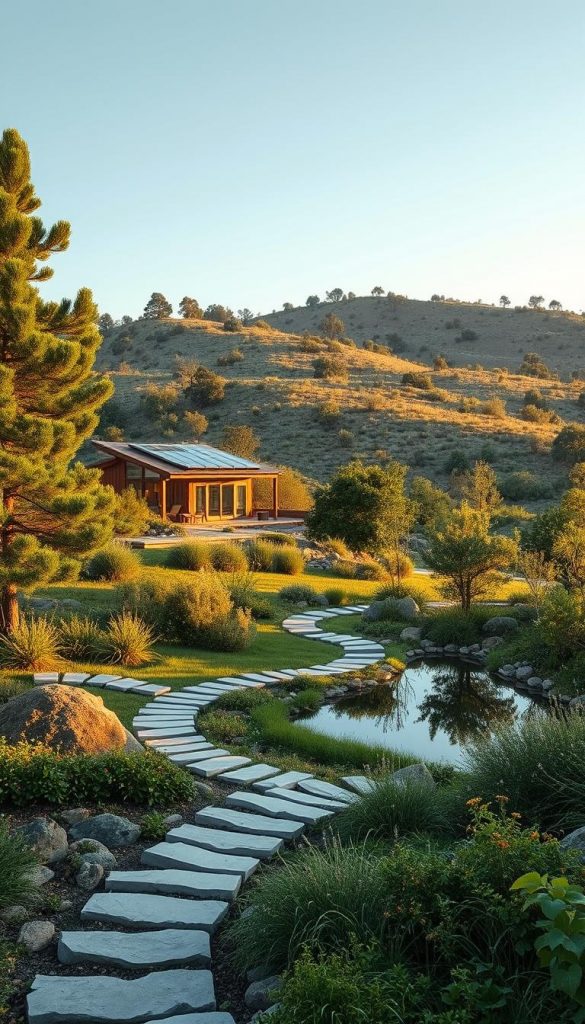
The Evolution of Green Building Practices
Green building practices have grown to reduce environmental harm. Buildings are big polluters, causing 40 percent of global emissions. This is due to their energy use and the energy needed to make and transport materials.
Historical Roots of Sustainable Architecture
Sustainable architecture started long ago. Ancient Greeks, for example, used the sun to warm their homes. This shows how old ideas can help us today.
Modern Sustainable Design Movement
Now, new tech and materials drive sustainable design. Sustainable materials like recycled wood and eco-friendly concrete are gaining favor.

Future Trends in Green Building
Green building’s future includes more renewable energy and innovative sustainable materials. Energy-saving designs will also play a big role.
| Trend | Description | Impact |
|---|---|---|
| Renewable Energy Integration | Incorporating solar, wind, and other renewable energy sources into building design. | Reduces reliance on fossil fuels, lowering emissions. |
| Sustainable Materials | Using materials that are recycled, recyclable, or sustainably sourced. | Minimizes environmental footprint and promotes eco-friendly practices. |
| Energy-Efficient Design | Designing buildings to minimize energy consumption through efficient systems and layouts. | Lowers energy costs and reduces environmental impact. |
Key Benefits of Sustainable Design
Using sustainable design can make a big difference. It improves the environment, saves money, and makes people healthier. Sustainable homes use less energy and water and make less waste. They are comfortable and stylish too.
Environmental Impact Reduction
Sustainable design helps reduce our harm to the planet. It uses two main strategies:
Carbon Footprint Minimization
Designing with energy-saving systems and renewable energy cuts down carbon emissions. This fight against climate change and lessens our use of fossil fuels.
Ecosystem Preservation
It also keeps natural ecosystems safe. Sustainable design uses sustainable materials and disturbs the land less. This helps keep biodiversity and ecosystem services strong.
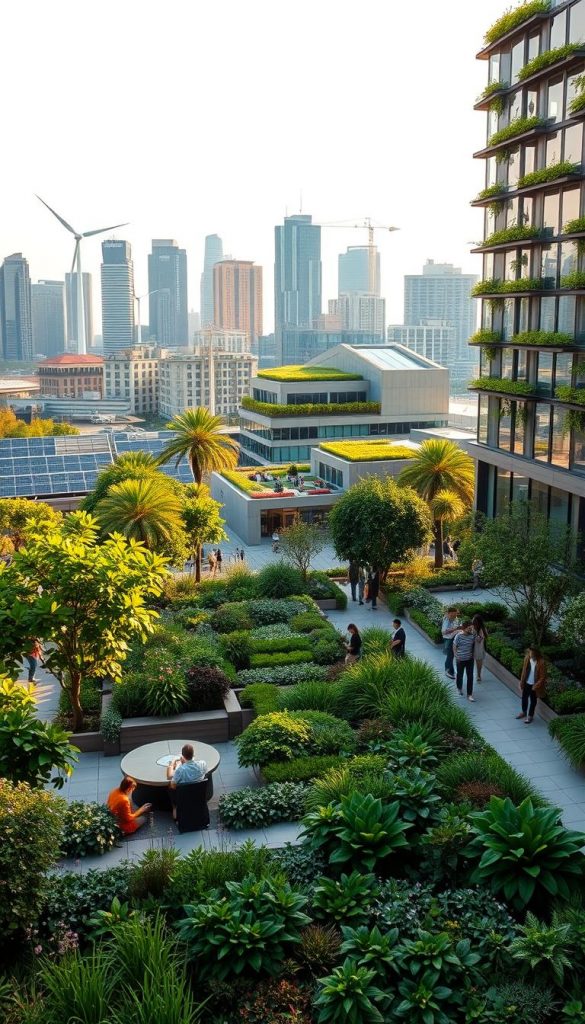
Economic Advantages
Sustainable design also saves money in the long run. It offers both short-term and long-term financial benefits. Key advantages include:
Long-term Cost Savings
It costs less to run because it uses less energy and water. These savings add up over time.
Increased Property Value
Properties with green design elements often increase in value. They attract buyers who care about the environment. People see the value in their energy-saving features.
| Benefit | Description | Impact |
|---|---|---|
| Carbon Footprint Reduction | Energy-efficient systems and renewable energy | Reduced greenhouse gas emissions |
| Ecosystem Preservation | Sustainable materials and minimal land disturbance | Maintained biodiversity |
| Long-term Cost Savings | Energy and water efficiency | Lower operating costs |
Health and Wellbeing Improvements
Sustainable design also boosts health and wellbeing. It uses safe materials, improves air quality, and lets in more natural light.
By choosing sustainable living and eco-friendly construction, we build healthier, greener spaces. These spaces are good for the planet and for the people who live there.
Sustainable Materials for Eco-Conscious Homes
Building an eco-friendly home starts with picking the right materials. The construction world uses a lot of natural resources and makes a lot of waste. Choosing sustainable materials helps homeowners lessen their impact on the environment.
Reclaimed and Recycled Building Materials
Using reclaimed wood, recycled steel, and salvaged materials cuts down on waste. It also adds a special touch to homes. Reclaimed wood brings history into your home, while recycled steel is strong and durable.
Renewable Resources in Construction
Renewable resources are getting more popular in building. They are good for the planet and the environment.
Bamboo and Fast-Growing Woods
Bamboo grows fast and is very versatile. It’s great for floors, furniture, and even building parts. Other quick-growing woods like poplar and eucalyptus are also being used more because they’re sustainable.
Cork and Other Natural Alternatives
Cork is soft, strong, and keeps moisture out. It’s perfect for floors and insulation. Other natural options like straw bales and rammed earth are used for keeping buildings warm.
Innovative Eco-Friendly Composites
New eco-friendly composites are being made all the time. They’re made from recycled plastics, farm waste, and other plant-based materials. These materials are strong and good for the planet.
| Material | Sustainability Features | Common Uses |
|---|---|---|
| Reclaimed Wood | Reduces waste, unique character | Flooring, feature walls |
| Bamboo | Fast-growing, renewable | Flooring, furniture, structural elements |
| Cork | Renewable, durable, resistant to moisture | Flooring, insulation |
Energy-Efficient Design Strategies
As we aim for a greener future, energy-efficient design is key. It’s not just about saving energy. It’s about making buildings comfy, healthy, and productive.
Passive Solar Design Principles
Passive solar design cuts down on heating and cooling costs. It uses the sun’s energy wisely. This method requires careful planning.
Building Orientation and Window Placement
The way a building faces and where its windows are placed matter a lot. They help use natural light and heat. This cuts down on the need for artificial lights and heating.
Thermal Mass Implementation
Thermal mass materials soak up and release heat. This helps keep a building’s temperature steady. It saves energy by needing less mechanical heating and cooling.
High-Performance Insulation Solutions
Good insulation keeps the inside temperature stable. This means less energy for heating and cooling. New insulation materials work better and are kinder to the planet.
Renewable Energy Integration
Renewable energy is vital for energy-efficient design. It uses clean energy from the sun and earth. This reduces dependence on fossil fuels.
Solar Power Systems
Solar power turns sunlight into electricity. It’s a clean energy source. Solar panels and building-integrated photovoltaics are ways to use it in buildings.
Geothermal Heating and Cooling
Geothermal systems use the earth’s heat for heating and cooling. It’s efficient, mainly in areas with steady underground temperatures.
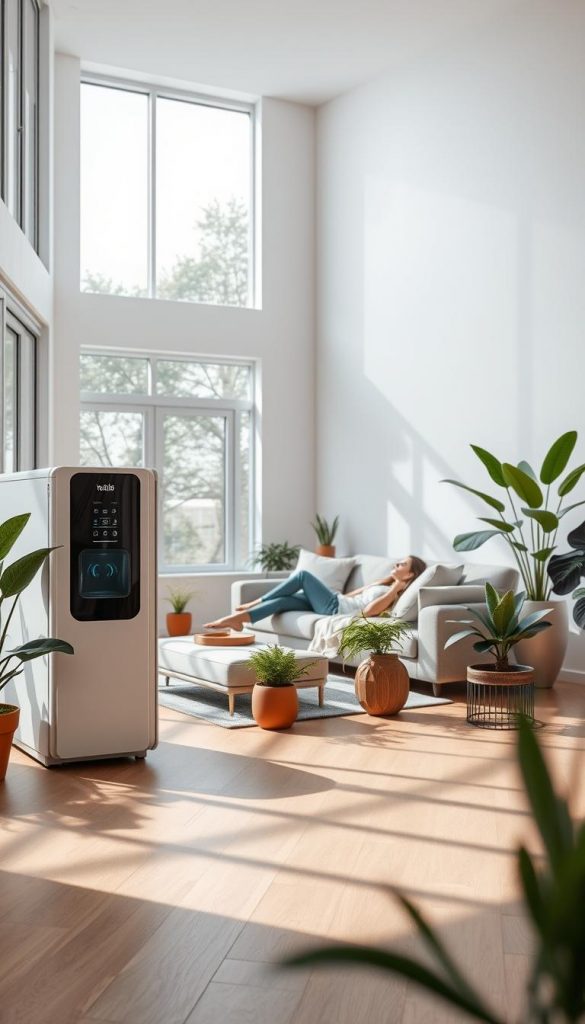
Using these strategies, buildings can be greener and healthier. As we seek sustainable development, energy-efficient design will grow more important.
Water Conservation in Environmentally Conscious Design
Water conservation is key in environmentally conscious design. There are many ways to cut down on water waste.
Methods like rainwater harvesting and greywater recycling can help save water. These strategies are effective in reducing water usage.
Rainwater Harvesting Systems
Setting up a rainwater collection system is a smart move. It saves water for your garden or landscaping. It also cuts down on stormwater runoff.
Greywater Recycling Technologies
Greywater recycling uses wastewater from sinks and showers for irrigation. It also helps with flushing toilets. This method greatly reduces the need for clean drinking water at home.
Drought-Resistant Landscaping
Drought-resistant landscaping is a smart choice for saving water. This includes xeriscaping and using native plants.
Xeriscaping Principles
Xeriscaping uses plants that need little water and efficient irrigation. It also involves using mulch and drought-tolerant plants.
Native Plant Selection
Native plants need less water and care. Choosing the right native plants makes your landscape beautiful while saving water.
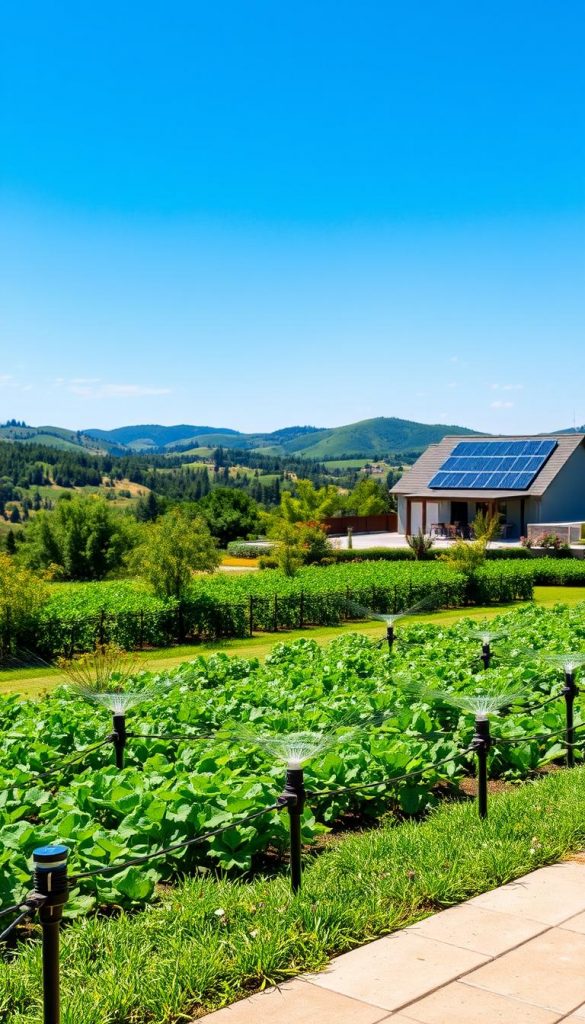
Indoor Environmental Quality and Sustainable Living
Creating a healthy indoor environment is key for sustainable living. It’s important to use non-toxic materials and finishes.
Non-Toxic Materials
Choosing non-toxic materials is vital for a healthy home. Look for materials with low VOC emissions.
Low-VOC Paints
Low-VOC paints help keep the air clean indoors. They come in many colors and finishes.
Formaldehyde-Free Products
Formaldehyde-free products are a must for clean air. Check for certifications from trusted organizations.
Biophilic Design Elements
Bringing nature inside improves indoor air quality. Use natural materials and let in lots of natural light.
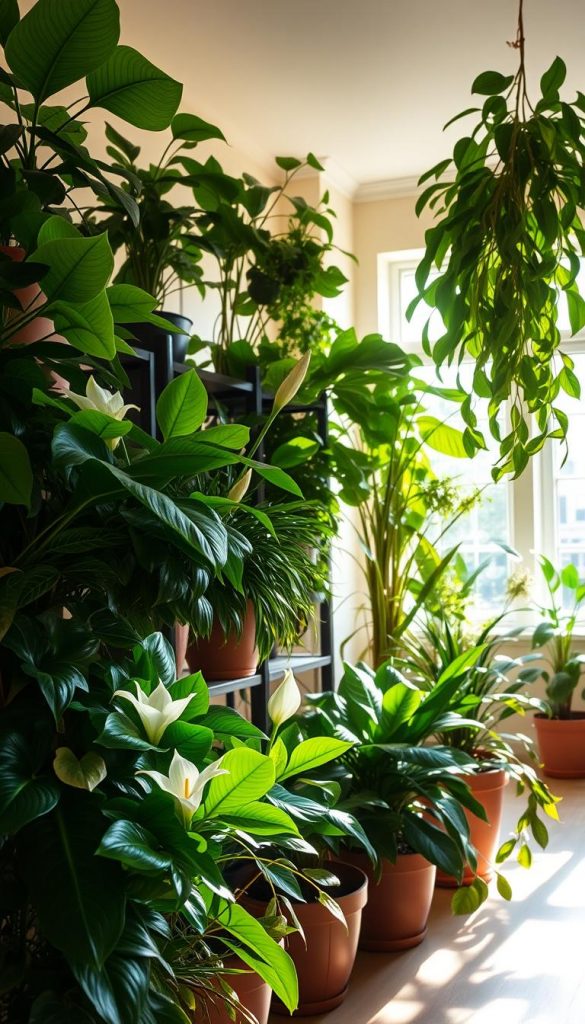
Sustainable Landscaping for Green Homes
Green homes need green surroundings. Sustainable landscaping is key. Outdoor spaces around our homes help reduce our environmental impact.
Permeable Surfaces and Rain Gardens
Using permeable surfaces and rain gardens is smart. Permeable pavers let rainwater soak through, cutting down on stormwater runoff. Rain gardens, filled with native plants, catch and clean rainwater, helping groundwater.
Edible Landscapes and Urban Farming
Edible landscapes and urban farming are becoming more popular. Growing our own fruits, veggies, and herbs cuts down on industrial farming. As Alice Waters, a pioneer of sustainable cuisine, said, “The most important thing about food is that it’s not just about food.”
“The garden is a love song, a duet between a human being and Mother Nature.” – Jeff Cox
Wildlife-Friendly Garden Design
Wildlife-friendly gardens are also important. They involve planting native plants, creating diverse habitats, and using fewer chemicals.
Pollinator Gardens
Pollinator gardens are essential. They support bees, butterflies, and other pollinators, vital for our ecosystem’s health.
Habitat Creation
Habitat creation means designing gardens for shelter, food, and breeding for various species. This boosts local biodiversity.
Combining rainwater collection with native plants boosts sustainable landscaping. Homeowners can make beautiful, useful outdoor spaces that help our environment.
Implementing Sustainable Design on Any Budget
You don’t need a lot of money to help the environment. Small changes can make a big difference. DIY and upcycling projects let you use what you already have, saving money and reducing waste.
Low-Cost Green Design Upgrades
Begin with easy, affordable changes that boost your home’s green factor. Here are a few ideas:
- Switch to energy-saving LED bulbs
- Choose paints with low VOCs for decorating
- Put in low-flow showerheads and faucets
DIY Energy Efficiency Improvements
DIY projects can make your home use less energy. For instance, sealing leaks around doors and windows or adding attic insulation can help a lot.
Upcycled Furniture and Decor
Upcycling old furniture or decor is good for the planet and adds character to your home. Try repainting or reupholstering old items to breathe new life into them.
Mid-Range Sustainable Investments
If you’re ready to spend a bit more, consider upgrades like a programmable thermostat or new, energy-saving windows.
High-Impact Eco-Friendly Renovations
For a bigger impact, think about big changes like solar panels or a rainwater system. These might cost more upfront but save money in the long run.
Start with small changes and then invest more as you can. Every step you take helps make your home greener and cheaper to run. It all adds up to a more eco-friendly and cost-effective home.
Green Building Certifications and Standards
Understanding green building certifications is key for homeowners and builders today. Governments worldwide are pushing for sustainable living. They offer incentives and tax breaks for eco-friendly home upgrades.
LEED Certification Process
The LEED (Leadership in Energy and Environmental Design) certification is a top choice for green buildings. It looks at energy use, water, and air quality. Getting LEED certified means a detailed check and verification.
ENERGY STAR Ratings for Homes
ENERGY STAR is a U.S. EPA program for energy-efficient homes. Homes that meet energy standards get the ENERGY STAR label. This is based on a home energy rating system.
Other Notable Certifications
Other green building certifications include the Living Building Challenge and Passive House Standards. The Living Building Challenge aims for buildings that are energy-efficient and healthy. Passive House Standards focus on using very little energy with advanced insulation and windows.
| Certification | Focus | Benefits |
|---|---|---|
| LEED Certification | Energy efficiency, water usage, indoor air quality | Enhanced market value, reduced operating costs |
| ENERGY STAR | Energy efficiency | Lower utility bills, improved indoor air quality |
| Living Building Challenge | Sustainable materials, energy efficiency, healthy environment | Net-positive energy, water, and waste; improved occupant health |
| Passive House Standards | Ultra-low energy consumption | Significant reduction in heating and cooling costs |
Collaborating with Sustainable Design Professionals
Working with the right sustainable design professionals is essential for your eco-friendly home. It’s important to find experts who share your commitment to sustainability. They can help make your sustainable home dreams a reality.
Finding Qualified Green Architects
To find a good green architect, look for those with experience in sustainable design. They should have certifications like LEED AP. They can make sure your project includes eco-friendly features.
Working with Eco-Conscious Interior Designers
Eco-conscious interior designers can help you pick materials and finishes that are both beautiful and sustainable. They can help you choose products with low VOC and sustainable sources.
Questions to Ask Before Hiring
Before hiring sustainable design professionals, ask about their experience with green projects. Also, ask about their design philosophy and how they keep up with sustainable practices.
Conclusion: Embracing a Sustainable Future
Living in today’s world means we must focus on a sustainable future. We can do this by living eco-friendly and using sustainable design. This helps us reduce our harm to the environment.
We can make the world greener, starting with our homes. Making smart choices about our living spaces is key. This includes the materials we use and how energy-efficient our homes are. Sustainable design improves our health and the planet’s.
Choosing sustainable design is a big step towards a better future. This article has shown how important it is to think about people, planet, and profit. Let’s keep working towards a world where living green is the standard.



